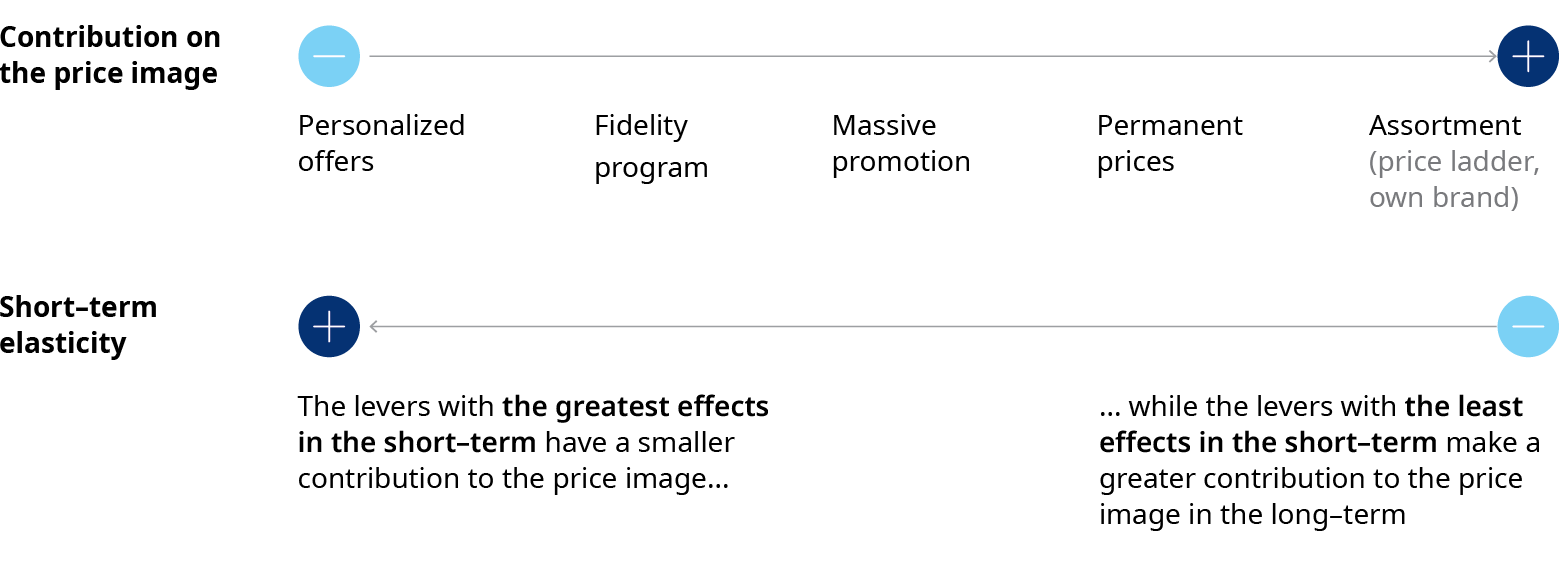


Evolving consumer behaviors
How To Influence Consumer Price Perception And Boost Sales
By Hunter Williams

Price is one of the main factors driving consumers’ choice of grocery store, and the current wave of inflation and economic uncertainty have made it all the more important. But consumers take a long time to change their perceptions. They build impressions over numerous store visits and are usually quite confident that they already know where they can find the best value.
The task for grocers is to identify what are the strongest influences on consumers’ perceptions. This entails taking into account factors such as value strategy, promotions, and communication. Understanding these elements, and how to best manage the levers, is the best path to boosting sales.
The effect of price on consumer perception
Decades of Oliver Wyman primary research suggests that a grocer’s influence on its consumer price perceptions involves several factors with distinct effects. Product assortment and base prices, for example, contribute strongly to long-term price perception but have only a moderate impact in the short-term. Promotions and loyalty programs, in contrast, can boost sales rapidly by providing immediate, short-term value – but have little lasting effect. The levers can be seen as inversely related lines of the contribution to the price image and the short-term elasticity of the efforts (See Exhibit 1).
Exhibit 1: Lines of the contribution to the price image and the short-term elasticities

Source: Oliver Wyman analysis
Value strategy requires understanding which levers to use when, and how to balance them. First, a grocer needs to be clear about what it is trying to achieve, over what period of time, and with what financial means. Then it can apply a smart combination of measures for maximum, sustainable effect. Finally, in order to get credit for the changes being made, it needs to strongly communicate on value to its shoppers.
Four effective levers to maximize value strategy
Value assortment benefits from a strategic product mix and private brands
The foundation of a grocer’s price image is what products it chooses to sell. A wide, low-cost assortment can be a powerful driver of awareness and traffic. That starts with a range skewed heavily toward entry- and average-price points. Given a typical three-tiered framework, a retailer with an assortment skewed heavily towards “good” products tends to benefit from better price perception than one in which the selection leans towards “better” and “best,” even if those higher-end products are priced competitively.
Private brands can play an important role, as they generally cost less than national brands. And grocers can also focus on categories with a greater impact on the price image. However, improving perception through assortment is not without short-term risks, as it can provide consumers with paths to trade down, reducing margins.
Base price changes affect perception on the entire store, but require time
The most obvious driver of long-term price perception is a grocer’s shelf prices. If some of these are lowered, price elasticity means customers will buy more of the products concerned. Halo effects follow – positive impacts on products that were not lowered in price. First, there is a basket effect, as lower prices for some products lead customers to buy more of other products too in the same trip. Then, a trip effect emerges, as the store as a whole is seen as better value, encouraging customers to visit more often.
However, base price is the driver that requires the most time to make its impact felt. Customers need time to notice, purchase after purchase, price reductions in a store. It may take more than two years to fully capture the positive effects of a price reduction, according to studies we have conducted in several countries. In the short-term, elasticities will typically pay for, at most, half of their cost, so grocers need to find sources of finance to cover these reductions at first.
Promotions are powerful, but can create a race to the bottom
Promotions are a powerful short-term driver of demand elasticity, as they directly draw attention to lower prices. But they have several drawbacks. First, their effect stops as soon as the price reduction ends, and they often leave behind a hangover after having shifted demand for a product forward or cannibalizing from elsewhere in the category. Second, especially if competitors match a promotion, a retailer might need to keep increasing its discount to continue to have the same effect — a kind of promotion addiction. Our work shows that a significant part of promotional activity actually costs more than the sales it generates.
But analytics can help identify the products for which promotions will have the most effect on customers’ perceptions. Grocers with the right analytical tools at their disposal can stop running the promotions that destroy value, run more of the most incremental promotions, and fine-tune their programs across the board.

Loyalty programs and targeted offer need to be balanced with fees or data analytics
Grocery loyalty programs have gone from being a differentiator to table stakes. In fact, customers use an average of seven different brands and the majority are involved in up to 10 active loyalty programs. The value offered by these programs is appreciated by consumers, but the cost might not actually be balanced out by increased loyalty and sales, potentially making them a zero-sum game (or worse).
But there are ways to make them work. One is to charge a fee for membership in the program, as Costco does. Another is leveraging the data they create to produce personalized offers that will be more relevant to each customer and generate a higher return on investment.
Five golden rules for good pricing communication
Once a grocer has worked out which pricing levers it wants to apply and how, it then needs to ensure it gets credit for them.
- Plan and direct: Know exactly what you want to accomplish, based on a defined purpose, formalized objectives, and the expected behavior of customers.
- Make it meaningful: Address customer demands, frictions and priorities, not just the retailer’s internal views of what matters.
- Keep messages clear, simple, and tangible: Convey messages as simply as possible with tangible evidence.
- Be consistent: Customers build their perceptions over repeated visits to a grocer. To strengthen the impact of the levers, they must be presented in ways that are coherent and consistent. That implies communication campaigns should back up and amplify customers’ experiences in the store.
- Sustain the effort: It takes time to change perception and behavior, so retailers need to be patient and resilient in their price campaigns and communications.
Conclusion
Along with location and product freshness, price perception is a fundamental driver of consumers’ decisions to shop — or not — in a store. Net promoter scores can help tell whether customers are happy, but price perception is more likely to tell you where they will spend their money. To improve price perception in a way that is both affordable and sustainable requires an understanding of the full value stack, and how it works together in concert. Successful price image improvement then needs to be planned, measured, and structured over time — and it needs a financing plan and coherent actions. With high inflation placing value at the top of consumers’ minds, getting it right has never mattered more.































